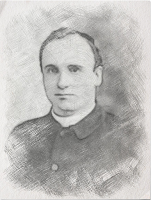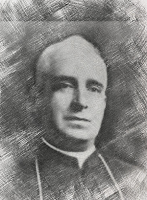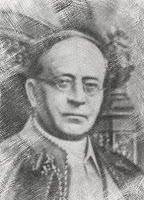As we saw in the previous posting on this subject, through some very skillful salesmanship and philosophical sleight-of-hand, the whole understanding of “natural law” in the western tradition was overthrown in many circles through the efforts of the Fabian socialists and Msgr. John A. Ryan of the Catholic University of America in the first half of the twentieth century. Nor did matters stop at mere theorizing.
Once he had secured his position at the Catholic University of America by putting the rector in his place and sabotaging the academic career of “the American Chesterton,” Fulton Sheen, Msgr. John A. Ryan began extending and enhancing his reputation as the premier authority on social justice in the United States. Nor was this a particularly difficult task, given his political acumen and the methods he employed; it was, in fact, in the reinterpretation of papal teaching that Ryan had his greatest influence.
As with so many others, Quadragesimo Anno gave Ryan the opportunity to claim papal endorsement of the New Christian understanding of Catholic social thought. In his autobiography, Ryan recorded his reaction to the encyclical. As he related,
 |
| Msgr. John A. Ryan |
On May 15, 1931, in the office of the New York Times, I listened to the transmission by radio from the Vatican of the words of the encyclical issued that day by Pope Pius XI. Long before the process was completed, I realized that this was an exceptionally great Papal message on the social question — powerful, comprehensive, traditionally Catholic, and, in the true sense of the word, radical. I also derived great comfort from the implicit approval which the Holy Father’s pronouncement gave to the socio-ethical doctrines which I had been defending for almost forty years. Referring to the new encyclical a few days later, Bishop Shahan, the rector of the Catholic University, observed: “Well, this is a great vindication for John Ryan.” (Ryan, Social Doctrine in Action, op. cit., 242.)
Shahan’s comment that the encyclical justified Ryan’s theories has been repeated to the point where it is now accepted without question by many authorities as the final word on the orthodoxy of Ryan’s thought. Unfortunately, Ryan is the only source for Shahan’s alleged statement.
 |
| Bishop Thomas Shahan |
It is, in fact, highly unlikely that Shahan said any such thing. On May 13, 1931, a few days before the release of the encyclical, Ryan testified before a special Visiting Committee at Catholic University, one of two committees appointed to investigate certain irregularities in the school of theology for which Ryan was believed responsible.
During the hearing Ryan made damaging — and demonstrably false — statements about Sheen, who was (in a sense) Shahan’s protégé. Further, Ryan was the cause of Sheen’s transfer out of the School of Sacred Sciences, now the School of Theology and Religious Studies.
The Visiting Committee was, in part, charged with looking into John A. Ryan’s efforts to remove James H. Ryan as rector. It would therefore not only have been imprudent and irregular, but grossly improper for Shahan as past rector to comment on anything connected with John A. Ryan, unless called to testify. It is inconceivable that Shahan would actually have made any statement in support of John A. Ryan, undercutting the current rector’s position and authority.
 |
| Pope Pius XI |
Nevertheless, despite the obvious contradictions in philosophy (especially the fact that Ryan’s interpretation of Catholic social teaching made as many people as possible dependent on the State), it has become customary to assume that Quadragesimo Anno and Ryan’s theories are fully compatible. As one biographer summarized Ryan’s analysis of Pius XI’s breakthrough in moral philosophy,
At first the encyclical seemed a perfunctory recollection of what Leo had already said. . . . however, it became apparent that the Pope was saying new things as well. He spoke of “social justice” several times, implying that measure of “distributive justice” that had been the burden of Ryan’s own book. For the worker’s right to “reasonable and frugal comfort,” the Pope now spoke of “ample sufficiency,” enough to maintain a worker and his family in decency. This was the “familial living wage” toward which Ryan had groped in A Living Wage. . . . In its section on “reconstructing the social order,” it urged cooperation among workers and masters in a guild system in which each industry governed itself under restraint by the State to prevent oppression of either the consumer. As if to distinguish this from the fascist corporations of Mussolini, the Pope warned the State against usurping private initiative or imposing an excessively bureaucratic domination. (Francis L. Broderick, Right Reverend New Dealer: John A. Ryan. New York: The Macmillan Company, 1963, 196.)
 |
| Fabians see themselves as wolves in sheep's clothing. |
This analysis, while an excellent précis of Ryan’s reformulation of papal teaching, has next to nothing to do with the matter of the encyclical. That — as the official title of the encyclical has it — is the restructuring of the social order through acts of social justice in order to provide the optimal environment within which each person can realize his fullest potential in a manner consistent with the demands of individual sovereignty, human dignity, and the common good.
Instead, consistent with New Christian thought, there is in Ryan’s analysis an obsessive focus on ameliorative measures. These were never intended as ends in themselves, but a way to ensure that people are taken care of properly during the transition to a more just society, empowering them to take care of themselves through their own efforts.
Even then, a just society is also not an end in itself. Rather, it is the environment within which people prepare themselves for their proper end by becoming more fully human.
 |
| Pope Leo XIII |
Ryan’s New Christian reorientation of papal teaching was therefore not merely overtly materialistic, it enthroned Collective Man in place of God. In common with the Fabians and the Fraticelli, Ryan’s thought substituted the expedient news of the social gospel of temporal wellbeing for the Good News of the Gospel of eternal salvation.
Pius XI’s new encyclical was therefore not a “vindication” of Ryan’s “socio-ethical doctrines which [he] had been defending for almost forty years” . . . implying — wrongly — that he had formed those doctrines based on Rerum Novarum. Rather, Quadragesimo Anno, “Forty Years After [Rerum Novarum]” was, in part, a stunning rebuke and a refutation of Ryan’s theories.
The pope’s language strongly suggests that he was fully aware of Ryan’s doctrines and the reinterpretations the latter had forced on Rerum Novarum. There also appear to be allusions to Ryan’s engaging in “controversies that are not always peaceful (Quadragesimo Anno, § 40.) in his attacks on Sheen and on the rector of Catholic University. As Pius XI explained,
We have described the remedies for these great evils so explicitly that We consider it sufficient at this point to recall them briefly. Since the present system of economy is founded chiefly upon ownership and labor, the principles of right reason, that is, of Christian social philosophy, must be kept in mind regarding ownership and labor and their association together, and must be put into actual practice. First, so as to avoid the reefs of individualism and collectivism. the twofold character, that is individual and social, both of capital or ownership and of work or labor must be given due and rightful weight. Relations of one to the other must be made to conform to the laws of strictest justice — commutative justice, as it is called — with the support, however, of Christian charity. Free competition, kept within definite and due limits, and still more economic dictatorship, must be effectively brought under public authority in these matters which pertain to the latter’s function. The public institutions themselves, of peoples, moreover, ought to make all human society conform to the needs of the common good; that is, to the norm of social justice. If this is done, that most important division of social life, namely, economic activity, cannot fail likewise to return to right and sound order. (Ibid., § 110.)
As Father William Ferree, a scholar in the social doctrine of Pius XI, remarked (not without a possible touch of sarcasm), “We can recall here the monumental good will and effort of Msgr. John A. Ryan to explain the new ‘Social Justice’ as Distributive Justice. Good will is not enough!” (Ferree, Forty Years After, op. cit.) Ferree, perhaps not by coincidence, attended the Catholic University of America during the final years of Ryan’s tenure.
#30#

